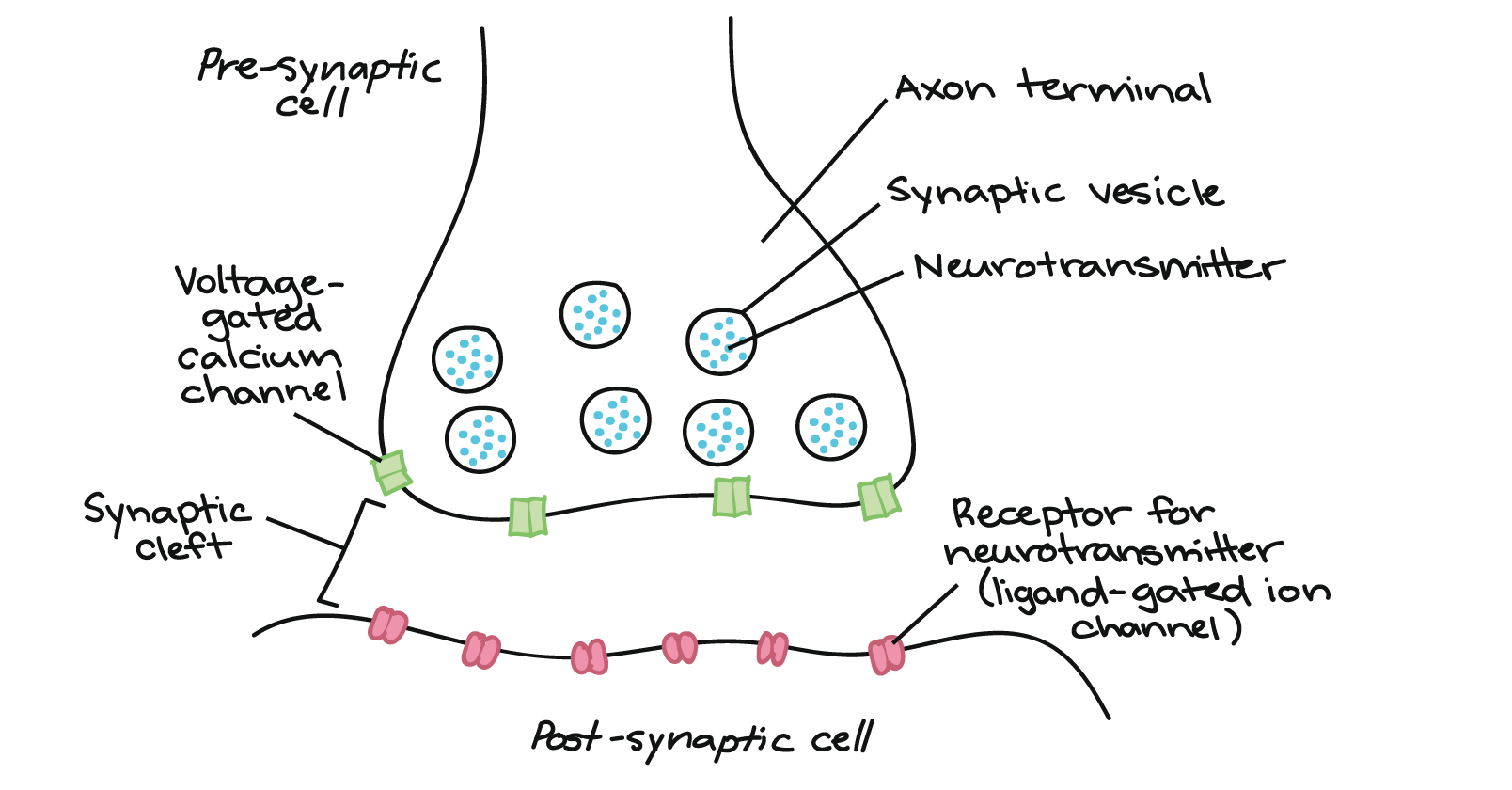Synaptic transmission

* Introduction
Impulses are transmitted from one neuron to another at synapses, these are junctions where the axon or some other portion of one cell –the presynaptic cell terminates on the dendrites, soma, or axon of another neurons or in some cases a muscle or gland cell-the postsynaptic cell
* Types of transmission :
1- Chemical
Transmission at most synaptic junctions is chemical, the impulse in the presynptic axon causes secretion of neurotransmitter and binds to receptors on the surface of postsynaptic cell, and this events that open or close channels in the membrane of postsynaptic cell
2- Electrical
At some of junction transmission is electrical .the neuron is directly adjacent to other neurons. Small holes in each cell's membrane, called gap junctions, are juxtaposed so that as the action potential reaches the end of the axon (at the terminal boutons), the depolarization continues across the membrane to the postsynaptic neuron directly.
3- Both
at a few conjoint synapses it is both electrical and chemical.
The effects of discharge at synaptic endings can excitatory or inhibitory .
Transmission from nerve to muscle is chemical transmission.The neuromuscular junction.
* Synapse Structure :
1- Synaptic cleft :
Each presynaptic of chemical synapse is separated from the postsynaptic structure by synaptic cleft that is 20-40nm wide.
2- postsynaptic terminal :
postsynaptic membranes contain neurotransmitter receptors, and usually a postsynaptic thickening called postsynaptic density, which is complex of specific receptors, binding proteins and enzymes induced by postsynaptic effects.
3-presynaptic terminal :
Inside the presynaptic terminal many mitochondria and many vesicles contain neurotransmitters, there are three kinds of synaptic vesicles :
* small, clear synaptic vesicles that contain acetylcholine, glycine, GABA, or glutamate
* small vesicle with dense core that contain catecholamine
* large vesicle with dense core that contain neuropeptides.
¤ There are areas of the membrane thickening called -active zones - which contain many proteins and rows of calcium channels.
* Transmission :
1-When the action potential arrives from the axon, it causes the calcium channels to open, increase the membrane permeability to calcium.
2-The intracellular calcium attract the vesicles to fuse with membrane and release their contents by exocytosis.
3-The released transmitter diffuses into the synaptic cleft and combine with specific receptors for that transmitter on the postsynaptic membrane.
4- the change the permeability of the postsynaptic membrane to specific ions and results in postsynaptic potential.
* If this potential is depolarized and reach the membrane threshold level, an AP results..
- Depending on the type of synapse or transmitter, the potential can be excitatory or inhibitory.
-Single post synaptic potentials (PSPs) do not usually cause any excitation or inhibition in postsynaptic neuron because the change membrane potentials does not reach the threshold to produce a response, but they may prouduce partial depolarization or hyperpolarization . threshold is reached by spatial or temporal summation and can be excitatory or inhibitory .
- Spatial summation:
A number of synaptic knobs release their transmitter at same time on single postsynaptic membrane and each produce a local depolarization. Summation due to stimulation of a number of synaptic knobs releasing on one postsynaptic neuron
-Temporal summation:
If one synaptic knob is repetitively stimulated, its postsynaptic local may add up and reach threshold to fire an action potentiall.
*Synaptic delay
After maximal stimulation, the minimum time required for an impulse from a presynaptic to produce a response in the postsynaptic neuron is 0.5ms. This is called (synaptic delay) . This is time taken for transmitter to be released from vesicles and produce an AP in postsynaptic neuron. A polysynaptic pathway have a delay corresponding to the number of synapses







No comments:
Post a Comment